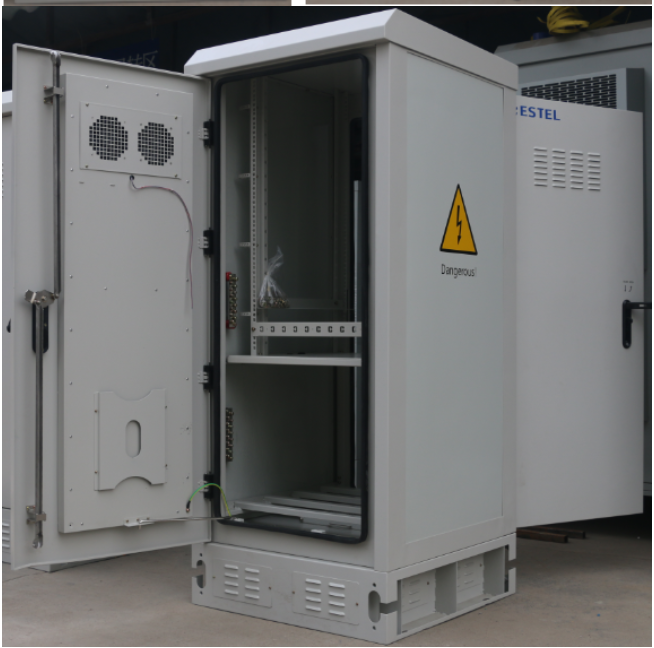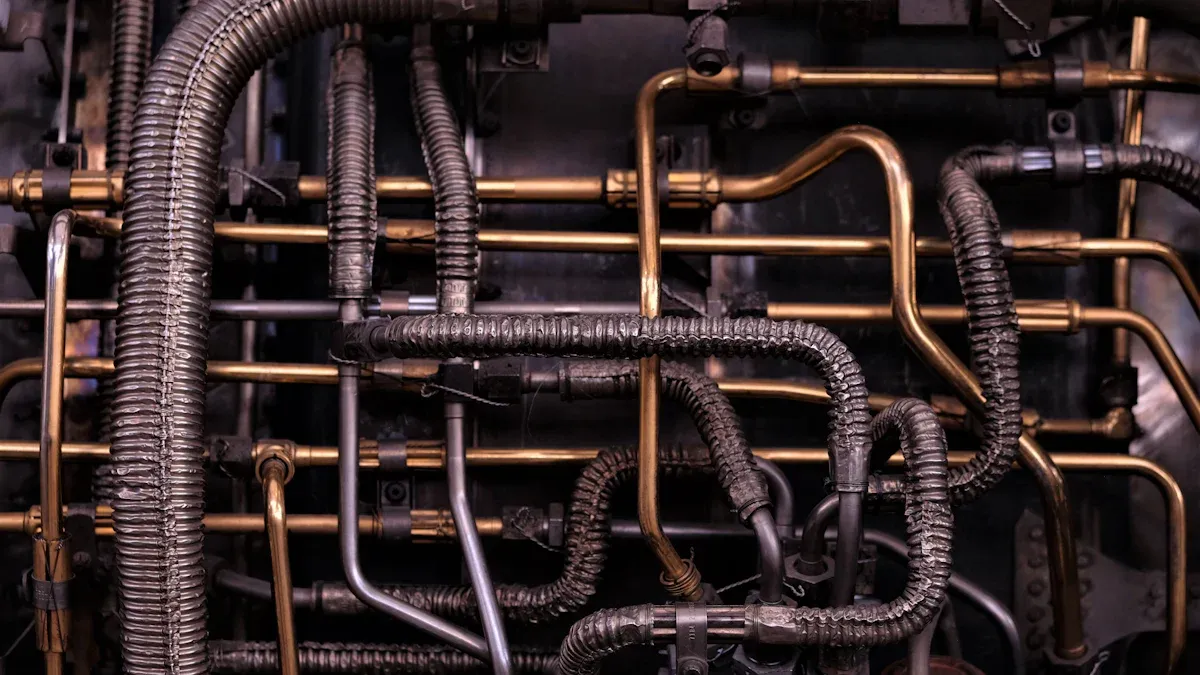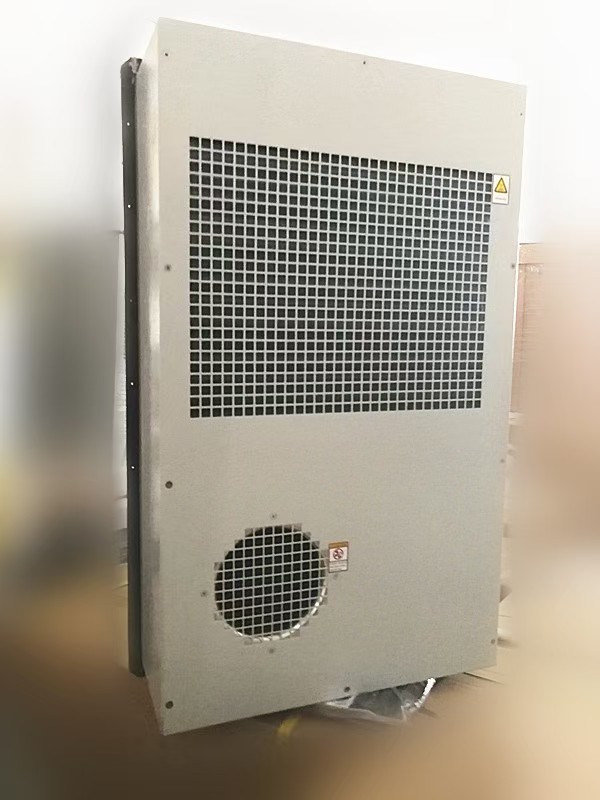Why Outdoor Cabinet Heat Exchanger Matters More Than You Think

You might not realize how much an Outdoor Cabinet Heat Exchanger matters until your equipment faces extreme heat or harsh weather. Overheating can cause electronics to fail, leading to expensive repairs or data loss. When you use proper cooling, you protect sensitive systems and maintain reliability. Many people overlook these benefits and focus only on short-term costs. Investing in the right solution keeps your outdoor equipment safe and running longer.
Key Takeaways
Outdoor Cabinet Heat Exchangers protect sensitive equipment from heat, dust, and moisture, preventing costly failures.
Proper cooling extends equipment life by keeping temperatures stable and reducing wear from harsh weather.
Heat exchangers use less energy than traditional air conditioners, saving money and reducing environmental impact.
Closed-loop designs keep contaminants out, ensuring reliable operation even in tough outdoor conditions.
Choosing the right heat exchanger and maintaining it regularly helps avoid repairs, lowers costs, and keeps systems running smoothly.
What Is It?
Outdoor Cabinet Heat Exchanger Basics
You might wonder why an Outdoor Cabinet Heat Exchanger is so important for your outdoor electronics. This device keeps your equipment cool and safe from harsh weather. You can find different types, such as air-to-air, air-to-water, and thermoelectric coolers. Each type fits a specific need:
Air-to-air exchangers: Move heat between two airflows without mixing them. They work well in clean environments and need little maintenance.
Air-to-water exchangers: Use water to handle higher heat loads. You often see these in industrial or data center settings.
Thermoelectric coolers: Offer precise temperature control in small spaces.
Note: Outdoor Cabinet Heat Exchangers use corrosion-resistant materials like stainless steel or aluminum. This protects your equipment from rain, salty air, and pollution.
Industry standards matter, too. Look for UL certification (ANSI Standard 1995, UL Type 4X) and GR-487 compliance. These show the product meets strict safety and durability rules.
How It Works
You need to know how an Outdoor Cabinet Heat Exchanger protects your equipment. The system uses basic heat transfer methods: conduction, convection, and sometimes phase change. Here’s how the process works:
Internal heat from electronics moves to metal coils (conduction).
Fans push air or water over these coils (convection), carrying heat away.
In some designs, sealed tubes use liquid that changes to gas and back, moving heat without extra power.
A closed-loop system keeps outside air and contaminants away from your sensitive electronics. This design prevents dust, moisture, and pests from entering the cabinet. Sensors and fans help maintain steady temperatures, even when the weather changes.
Regular cleaning and inspection keep the system running well. You should check for airflow blockages and make sure seals stay tight. This attention helps your equipment last longer and work reliably, even in tough outdoor conditions.
Risks of Poor Cooling
Equipment Failure
You face a high risk of equipment failure when outdoor cabinets do not have proper cooling. Outdoor environments expose your electronics to temperature swings, humidity, and dust. These factors speed up wear and tear. For example, dust and debris can block airflow, which reduces cooling capacity. Fan motors may fail, causing poor air circulation and overheating. Coolant leaks or incorrect coolant levels also lead to severe overheating and pressure damage. Clogged air filters further restrict airflow, making the system work harder and less efficiently.
Tip: Regular inspections and cleaning help you catch these problems early and keep your equipment running longer.
If you let temperatures rise above recommended levels, you increase the chance of failure. Studies show that running IT hardware at 77°F (25°C) instead of 68°F (20°C) can raise annual component failure rates by up to 43%. Hard drives are especially sensitive to heat, and even a small increase in temperature can shorten their lifespan.
Higher Costs
Poor cooling does not just damage your equipment—it also hits your budget. When cooling systems fail, you spend more on repairs and replacements. You may also see higher energy bills. Faulty cooling components can waste up to 40% of the system’s total energy use. Frequent breakdowns mean more downtime, which interrupts your operations and increases labor costs.
You pay more for emergency repairs.
Replacement parts and new equipment add up quickly.
Downtime leads to lost productivity and revenue.
Early detection and preventive maintenance save you money in the long run.
Safety Issues
Ignoring cooling problems can create serious safety hazards. Overheated equipment may spark fires or cause electrical malfunctions. Corrosion from humidity can weaken cabinet structures, leading to leaks or even catastrophic failure. Scaling and biofouling from poor water quality reduce system efficiency and increase the risk of breakdowns.
Note: Routine maintenance and protective coatings help you avoid these dangers and keep your outdoor equipment safe.
By understanding these risks, you see why investing in proper cooling for your outdoor cabinets is not just smart—it is essential for safety, reliability, and cost control.
Outdoor Cabinet Heat Exchanger Benefits

Longer Equipment Life
You want your outdoor electronics to last as long as possible. An Outdoor Cabinet Heat Exchanger helps you achieve this by keeping internal temperatures within safe limits. High temperatures and rapid temperature swings can damage sensitive components. When you lower the operating temperature by just 10°F, you can double the life of your electrical equipment. This fact shows why proper cooling matters so much.
Heat exchangers use closed-loop designs to separate the inside air from the outside environment. This prevents dust, moisture, and other contaminants from reaching your electronics. Air-to-air models transfer heat without mixing air streams, which protects your equipment from pollution and humidity. Liquid-to-air types handle higher heat loads and work well in places where air cooling alone is not enough. These systems often use advanced technologies like heat pipes or nanofluids to boost cooling performance.
You see the benefits in real-world settings. For example, electrical enclosures near ovens or in hot climates often fail without proper cooling. When you use a heat exchanger, you keep the temperature stable and prevent dust from building up inside. This reduces the risk of thermal runaway and keeps your equipment running longer.
Tip: Regular maintenance and sealed cabinet designs help you avoid costly repairs and extend the lifespan of your electronics.
Energy Savings
You might wonder why an Outdoor Cabinet Heat Exchanger is more energy efficient than traditional cooling systems. The answer lies in how these devices manage heat. They use less energy because they transfer heat directly, instead of relying on compressors or refrigerants. This approach saves you money and reduces your environmental impact.
Here is a quick comparison of energy savings:
Metric Description | Numerical Comparison |
|---|---|
Over 40% compared to traditional cooling systems | |
Internal cabinet temperature control | Maintained within 5°F above ambient temperature under heavy load |
Energy consumption relative to traditional methods | Consumes 40% less energy |
You can see that heat exchangers keep your equipment cool while using much less power. This efficiency means you spend less on electricity and reduce your carbon footprint. Many models also support remote monitoring, so you can track performance and spot issues before they become problems. Some units comply with ROHS and operate on 48V DC, making them suitable for modern, energy-conscious installations.
Reliable in Harsh Environments
You need reliable cooling when your equipment faces rain, snow, dust, or extreme heat. Outdoor Cabinet Heat Exchangers deliver this reliability through rugged construction and smart design. Manufacturers build these units with corrosion-resistant materials, weather-tight seals, and UV-resistant finishes. These features protect your electronics from water, salt air, and sunlight.
You also benefit from advanced controls and monitoring. Many heat exchangers now include AI-driven management and IoT connectivity. These features let you monitor conditions remotely and adjust cooling as needed. Closed-loop systems keep contaminants out, while modular designs make upgrades and repairs easy.
Outdoor Cabinet Heat Exchangers maintain precise temperature control, which protects sensitive telecom and industrial equipment from heat damage.
Cabinets meet strict standards like NEMA, IP55+, GR-487, and NEBS Level 3, ensuring safety and durability.
Energy-efficient designs and smart controls lower your operational costs and support proactive maintenance.
You can deploy these cabinets in remote or harsh locations, knowing they will keep your equipment safe and functional.
Note: Choosing a heat exchanger with the right protection rating and compliance ensures your system works reliably, even in the toughest environments.
Heat Exchanger vs. Other Cooling

Air Conditioners and Fans
You might wonder why you should choose a heat exchanger over an air conditioner or a fan. Air conditioners use compressors and refrigerants to cool air below ambient temperature. They often run at only about 10% of their theoretical maximum efficiency, with an Energy Efficiency Ratio (EER) around 4.0, while the theoretical maximum is 37.5. Even with advanced heat exchanger designs inside air conditioners, their efficiency remains limited. Fans, on the other hand, simply move air to help with cooling. They can increase airflow and raise temperatures slightly, but they do not provide precise control or protection from contaminants.
When you compare these options, you see that an Outdoor Cabinet Heat Exchanger offers a closed-loop system. This design keeps dust, moisture, and pollutants out of your cabinet. Thermoelectric coolers, which use the Peltier effect, add benefits like low noise and high reliability. They also focus on energy efficiency and environmental friendliness, which traditional fans and air conditioners often lack.
You can see the performance differences in the table below:
Performance Metric | Cross-Flow Plate Heat Exchanger | Counter-Flow Plate Heat Exchanger |
|---|---|---|
Heat Exchanger Effectiveness | Lower than counter-flow at same NTU, but better under cabinet size constraints | Higher effectiveness at same NTU and heat capacity ratio |
Thermal Resistance | Lower in wider cabinets (better cooling) | Higher in some cabinet sizes due to flow direction |
Cooling Capacity (W/K) | 138.95 W/K at 700 mm width | |
System Dimension Impact | Outperforms counter-flow in limited size cabinets | Limited by cabinet size and flow channel |
This table shows why system dimensions and flow arrangement matter when you select a cooling method.
Best Use Cases
You need to know when a heat exchanger works better than other cooling solutions. Here are the best situations for using an Outdoor Cabinet Heat Exchanger:
You want to keep equipment at temperatures just above ambient, not below.
Your environment contains dust, oil, or other airborne contaminants.
You need a moderate-cost, closed-loop cooling option.
You require protection from outside air mixing with internal air.
You have access to a water cooling source in industrial settings.
You want to reduce maintenance and energy costs.
You need reliable operation in harsh or remote outdoor locations.
Tip: Choose a heat exchanger when you need contamination protection, cost savings, and low maintenance. Air conditioners work best when you must cool below ambient temperature, but they use more energy and require more upkeep.
You see that heat exchangers shine in outdoor applications where near-ambient temperature control is acceptable and equipment protection is critical. They offer a practical, efficient, and reliable solution for many outdoor cabinet needs.
Choosing the Right One
Key Features
You want to make the right choice when selecting an Outdoor Cabinet Heat Exchanger. The right features ensure your equipment stays safe and efficient. You should focus on technical criteria that match your needs. The table below shows why each factor matters:
Technical Criteria / Considerations | Description / Importance |
|---|---|
Heat Load (Wattage Dissipation) | You need to match the cooling capacity to the total heat your equipment generates. This prevents overheating and extends equipment life. |
Environmental Conditions | You must consider temperature swings, humidity, dust, and sunlight. These factors affect performance and durability. |
IP/NEMA Protection Rating | You want a rating like IP55 or higher. This keeps out water and dust, protecting sensitive electronics. |
Cabinet Size and Available Space | You need to fit the heat exchanger inside your cabinet. Limited space can restrict your options. |
Power Availability and Energy Efficiency | You should check if the unit matches your power supply and uses energy efficiently. This lowers costs and supports battery backup. |
Noise Level | You may need a quiet system for noise-sensitive areas. |
Maintenance and Reliability | You want easy maintenance and long-lasting parts. This reduces downtime and saves money. |
Budget and Total Cost of Ownership | You should balance upfront cost with long-term savings. |
You see that each feature plays a role in protecting your investment. Air-to-air models work well for moderate loads and sealed environments. Liquid-to-air types suit larger loads if you have a water source. Closed-loop designs keep out contaminants, which is critical for outdoor use.
Sizing and Setup
You need to size and set up your cooling system correctly to get the best results. Follow these steps to ensure reliable operation:
Identify the environmental conditions at your site. Check temperature extremes, humidity, dust, and sunlight.
Calculate the total heat load. Add up the heat from all components, the effect of outside temperatures, and solar gain.
Choose a cooling method that fits your needs. Use filtered fans for clean, mild environments. Pick a closed-loop Outdoor Cabinet Heat Exchanger for dusty or humid sites.
Design your system to keep the enclosure about 20°F below the equipment’s maximum safe temperature.
Set up monitoring and maintenance schedules. Use remote dashboards or programmable controls to track performance and catch problems early.
Consider adding heaters or humidity controls if your site faces cold or damp conditions.
Tip: Always balance cost, reliability, and maintenance when you select and install your cooling system. Proper setup prevents failures and keeps your equipment running smoothly.
You see why careful selection and setup matter. The right choices protect your equipment, save energy, and reduce long-term costs.
You protect your outdoor equipment best when you choose an Outdoor Cabinet Heat Exchanger. Efficient cooling systems help you avoid overheating, which reduces costly repairs and interruptions. You see benefits such as:
Lower failure rates and fewer technician visits
Longer equipment life from consistent temperature control
Reduced downtime and maintenance costs
You should review your current setup and consider upgrading. Proactive steps keep your systems reliable and your operations efficient.
FAQ
Why should you choose a heat exchanger over a traditional air conditioner for outdoor cabinets?
You should choose a heat exchanger because it uses less energy and needs less maintenance. It protects your equipment from dust and moisture. You get reliable cooling in harsh environments without the high costs of air conditioning.
Why does the closed-loop design matter for outdoor cabinet cooling?
A closed-loop design keeps outside air, dust, and water away from your electronics. You prevent contamination and reduce the risk of equipment failure. This design helps your system last longer and work more reliably.
Why do protection ratings like NEMA or IP55 matter for outdoor heat exchangers?
You need a high protection rating to keep water and dust out. Ratings like NEMA or IP55 show that your heat exchanger can handle tough weather. You get peace of mind knowing your equipment stays safe.
Why is regular maintenance important for outdoor cabinet heat exchangers?
Regular maintenance helps you catch problems early. You avoid costly repairs and downtime. Clean fans and tight seals keep your system running efficiently. You protect your investment and extend equipment life.
Why should you consider remote monitoring features?
Remote monitoring lets you track temperature and performance from anywhere. You spot issues before they cause failures. This feature saves you time and reduces emergency visits. You keep your equipment running smoothly.
See Also
Reliable Outdoor Cabinets Offering Cool And Controlled Protection
Understanding Outdoor Enclosure Cabinets And Their Key Advantages
Protecting Your Equipment With Durable Outdoor Cabinets Always
Choosing The Ideal Outdoor Electrical Cabinet For Your Requirements
CALL US DIRECTLY
86-13752765943
3A-8, SHUIWAN 1979 SQUARE (PHASE II), NO.111, TAIZI ROAD,SHUIWAN COMMUNITY, ZHAOSHANG STREET, NANSHAN DISTRICT, SHENZHEN, GUANGDONG, CHINA

